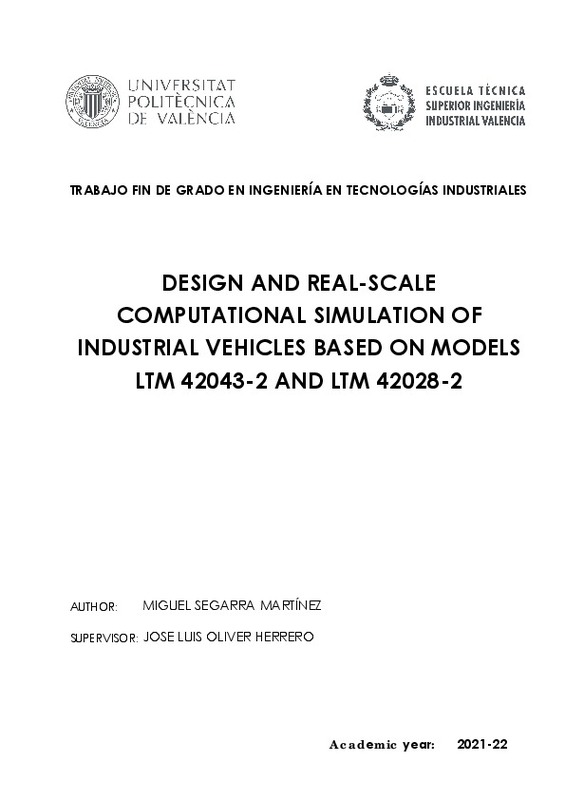|
Resumen:
|
[ES] El presente Proyecto “Trabajo Final de Grado” consiste en la adquisición de los conocimientos y
competencias necesarias para el manejo y dominio de los diferentes programas de diseño asistido
por ordenador, o ...[+]
[ES] El presente Proyecto “Trabajo Final de Grado” consiste en la adquisición de los conocimientos y
competencias necesarias para el manejo y dominio de los diferentes programas de diseño asistido
por ordenador, o Computational Aided Design (CAD), y de simulación de ingeniería, o Computer
Aided Engineering (CAE), todo ello con el principal objetivo de diseñar “mecanismos autoalineados”
de forma profesional. Se ha trabajado con el “SolidWorks® 2007 SP5.0”, el cual incluye el add-in de
“COSMOSMotion”, con el “SolidWorks® 2020” y con “RecurDyn”.
A partir de estudiar los mecanismos que los vehículos industriales y automóviles incorporan, así
como de los fundamentos y los elementos que posibilitan y explican el movimiento de los
mecanismos, se pretende realizar el diseño de todas las “restricciones cinemáticas” (rodamientos, …)
que participan en cada uno de los modelos, principalmente desde el punto de vista de la cinemática.
Cuando dicho diseño se realiza de forma que la “movilidad aparente”, o la capacidad de movimiento
que se desea que tenga un cierto mecanismo (o sistema móvil), coincide con la “movilidad
calculada”, o la capacidad de que se mueva según la disposición y selección de las restricciones, se
dice que el mecanismo está “autoalineado”. En el espacio, un cuerpo tiene 6 grados de libertad (gdl):
el movimiento rotacional alrededor de cada uno de los tres ejes (x-y-z), y el translacional por dichos
ejes. Cada ‘tipo’ de restricción permite y restringe un cierto número de grados de libertad.
Siempre que entre cada dos piezas haya un movimiento relativo, se debe contemplar la
incorporación de algún tipo de restricción cinemática. Y es precisamente por este motivo que realizar
un correcto estudio y diseño de los mecanismos y rodamientos de un sistema es fundamental. Por
ejemplo, se reduce la probabilidad de fallo del sistema, se alarga la vida útil de los mecanismos, se
reduce el coste de mantenimiento, y se consigue que el sistema sea tan útil como se diseñe.
Para la consecución de todo ello se ha utilizado una herramienta: los modelos de “LEGO® Technic
Model” (LTM) con su correspondiente código comercial. Una vez virtualizados, se les ha denominado
como “vLTm”.
[-]
[EN] This Bachelor’s Thesis consists of the acquisition of the necessary knowledge and skills for the
management and mastery of different programs of Computer-Aided Design, CAD, and Computer
Aided Engineering, CAE. The ...[+]
[EN] This Bachelor’s Thesis consists of the acquisition of the necessary knowledge and skills for the
management and mastery of different programs of Computer-Aided Design, CAD, and Computer
Aided Engineering, CAE. The use of these tools is to achieve the main objective: to design “selfaligning mechanisms” in a professional way. All work has been done by using “SolidWorks® 2007
SP5.0”, which includes the “COSMOSMotion” add-in, “SolidWorks® 2020”, and “RecurDyn”.
After studying the mechanisms that industrial vehicles and automobiles incorporate, as well as the
basis and elements that enable and explain the movement of the mechanisms, it is intended to
design all the “constraints” that participate in each of the models, mainly from a kinematic point of
view (bearings, …). When said design is made in such a way that the “apparent mobility”, or the
capacity of movement that a certain mechanism (or mobile system) is intended to display, coincides
with the “calculated mobility”, or the mechanism’s capacity to move according to the arrangement
and selection of the constraints, the mechanism is said to be "self-aligning". In space, a body has 6
degrees of freedom (DOF): the rotational movement around each of the three (x-y-z) axes, and the
translational movement along these axes. Each 'type' of constraint allows and restricts a certain
number of degrees of freedom.
Whenever there be a relative movement between two pieces, the incorporation of some type of
constraint should be considered. This is the reason why developing a correct study and design of the
mechanisms and bearings of a system is essential. For example, the probability of system failure is
reduced, the service life of the mechanisms is lengthened, maintenance cost is reduced, and the
system is made as useful as it be designed.
To achieve all this, a tool has been used: the “LEGO® Technic Models” (LTM) with their corresponding
commercial code. Once virtualized, they have been called as “vLTm”.
[-]
|







